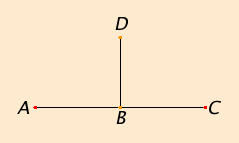In the figure, the two angles DBA and DBC are equal, so they are right angles by definition, and so the line BD set up on the line AC is perpendicular to it. Later there will be a postulate (Post.4) which states that all right angles are equal, and after a few propositions, it can be shown that AC is also perpendicular to BD. There are no postulates that explicitly state perpendiculars exist. Instead a construction for them is given and proved in proposition I.11.
The word orthogonal is frequently used in mathematics as a synonym for perpendicular.
